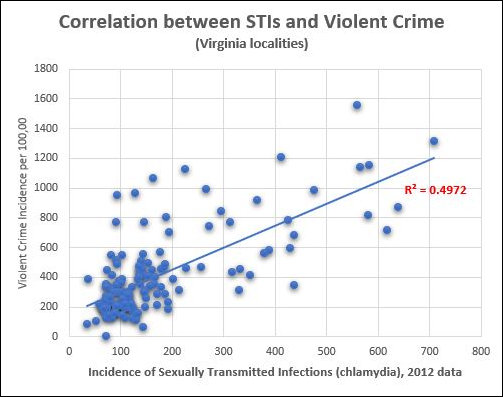In recent days I have been examining correlates between various social/economic indicators and violent crime. I have found only a weak crime-poverty link and a weak crime-teen birth link, but a moderate connection between the percentage of single-parent households in a Virginia locality and violent crime. In this post, I show the connection between, of all things, Sexually Transmitted Infections and violent crime.
The graph above shows the correlation between the incidence of chlamydia, a sexually transmitted disease, per 100,000 population and the incidence of violence crime per 100,000, as reported by County Health Rankings and Roadmaps. There is a moderate correlation — an R² of .4972, far stronger than for poverty and teenage births, and stronger even than for the incidence of single-parent households.
Correlation, of course, does not indicate causation. It would be ludicrous to suggest that catching a sexually transmitted diseases causes people to engage in violent crime. But that doesn’t render the correlation meaningless. I hypothesize that the incidence of violence and STIs have common factors behind them.
What are those common factors? Here’s what I conjecture. The incidence for STIs is a proxy for sexual promiscuity. Men and women who limit their sexual activity to monogamous relationships are far less likely to contract chlamydia than men and women who have numerous sex partners. Sexual promiscuity (having sex with multiple partners) is closely linked to other behaviors and attitudes such as substance abuse, a lack of impulse control, and an inability or unwillingness to consider the consequences of one’s actions — and those traits are associated with violent behavior.
If we as a society want to combat violent crime, addressing STIs through better health programs will have no effect. (Such programs might drive down STIs but they won’t drive down violence.) What this data does suggest is that if we want to reduce violent crime, addressing “poverty” through conventional means won’t reduce violent crime either. If I’m right, an important root cause is attitudinal — lack of impulse control, the inability to defer gratification, and related traits that lead to self-destructive behavior. Those attitudes must change. How we alter them is the subject for another debate.



